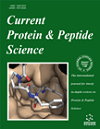- Home
- A-Z Publications
- Current Protein and Peptide Science
- Previous Issues
- Volume 19, Issue 9, 2018
Current Protein and Peptide Science - Volume 19, Issue 9, 2018
Volume 19, Issue 9, 2018
-
-
Therapeutic Targeting of Amyloid Precursor Protein and its Processing Enzymes for Breast Cancer Treatment
More LessAuthors: Syed Mohd. Danish Rizvi, Talib Hussain, Gehad M. Subaiea, Shazi Shakil and Adnan AhmadBreast cancer cases in women are increasing at an alarming rate globally and extensive research is being conducted to identify a breakthrough medicine against this dreadful disease. In fact, researchers are looking for fresh targets to develop novel treatment strategies for cancer of the breasts. In this article, ‘amyloid precursor protein’ or (APP) and its processing enzymes are deeply studied so as to explore the same as Read More
-
-
-
Mitochondrial Dynamics and Proteins Related to Neurodegenerative Diseases
More LessDisruptions in the regulation of mitochondrial dynamics and the occurrence of proteins misfolding lead to neuronal death, resulting in Age-related Dementia and Neurodegenerative diseases as well as Frailty. Functional, neurophysiologic and biochemical alterations within the mitochondrial populations can reveal deficits in brain energy metabolism resulting in Mild Cognitive Impairment, abnormal neural development, auton Read More
-
-
-
Emerging Targets and Latest Proteomics Based Therapeutic Approaches in Neurodegenerative Diseases
More LessAuthors: Munazza T. Fatima, Zeyaul Islam, Ejaj Ahmad and Parveen SalahuddinProtein homeostasis (proteostasis) is achieved by the interplay among various components and pathways inside a cell. Dysfunction in proteostasis leads to protein misfolding and aggregation which is ubiquitously associated with many neurodegenerative disorders, although the exact role of these aggregate in the pathogenesis remains unknown. Many neurodegenerative diseases, including Alzheimer's disease, Parkinson's dis Read More
-
-
-
Proteins Commonly Linked to Autism Spectrum Disorder and Alzheimer's Disease
More LessAuthors: Athanasios Alexiou, Georgia Soursou, Nagendra S. Yarla and Ghulam Md AshrafSeveral years after the first publication of Barker's Hypothesis the identification of common patterns and pathways between genetic and epigenetic risk factors in neurodegenerative disorders is still an open problem. For the cases of Alzheimer's disease and Autism and by taking into consideration the increasing number of diagnosed cases globally, scientists focused on commonly expressed and related proteins like A Read More
-
-
-
Impact of Hydroxyl Radical Modified-Human Serum Albumin Autoantigens in Systemic Lupus Erythematosus
More LessAuthors: Md. A. Khan, Khursheed Alam, Ghulam Md Ashraf and M. Moshahid A. RizviFree radicals are important mediators for cell toxicity and pathogenesis of diseases. Reactive oxygen species (ROS) have been generated broadly in inflammatory diseases including autoimmune diseases. ROS have been not only associated with the initiation and progression of the autoimmune response but also in amplification and exploring to novel epitopes, through the unveiling of antigenic determinants. This review explores Read More
-
-
-
Fate of T Cells and their Secretory Proteins During the Progression of Leprosy
More LessAuthors: Mohd Tarique, Chaman Saini, Huma Naz, Raza A. Naqvi, Faez Iqbal Khan and Alpana SharmaLeprosy is an infectious disease caused by non-cultivable bacteria Mycobacterium leprae. Ridley and Jopling classified the disease into five polar forms, Tuberculoid (TT) and Lepromatous (LL), in between two forms of the disease Borderline tuberculoid (BT), Borderline (BB) and Borderline lepromatous (BL) are laid. The tuberculoid type (BT/TT) leprosy patients show good recall of cellmediated immune (CMI) response and T Read More
-
-
-
Rheumatic Heart Disease: Pathogenesis and Vaccine
More LessAuthors: L. Guilherme, S. F. de Barros, K.F. Kohler, S.R. Santos, F. Morais Ferreira, W.R. Silva, R. Alencar, E. Postol and J. KalilRheumatic fever (RF) and rheumatic heart disease (RHD) follow untreated S. pyogenes throat infections in children who present susceptible genes that favor the development of autoimmune reactions. In this review, we focus on the genes that confer susceptibility and on the autoimmune reactions that occur due to molecular mimicry between human-tissue proteins and streptococcal M protein. Polyarthritis is the initial ma Read More
-
-
-
Understanding the Role and Mechanism of Carbonic Anhydrase V in Obesity and its Therapeutic Implications
More LessAuthors: Aarfa Queen, Parvez Khan, Amir Azam and Md. I. HassanObesity is a metabolic syndrome leading to several health problems such as hypertension, heart attack, type II diabetes, and even cancer. Carbonic anhydrase VA (CAVA) is a mitochondrial enzyme which is directly associated with the glucose homeostasis and considered as a promising target for obesity and other associated diseases in humans. So far, numerous inhibitors have been designed to inhibit the catalytic activity of CAVA Read More
-
-
-
Urotensin II: Molecular Mechanisms of Biological Activity
More LessUrotensin II (UT II) is an important factor of cellular homeostasis. This regulatory peptide is involved in the pathophysiology of many disorders. For example, it plays an important role in the pathogenesis of acute and chronic diseases, stressful and adaptive reactions of the body, in the development of cardiovascular pathologies, metabolic syndrome, inflammation, liver cirrhosis, renal failure, diabetic nephropathy, repro Read More
-
Volumes & issues
-
Volume 26 (2025)
-
Volume 25 (2024)
-
Volume 24 (2023)
-
Volume 23 (2022)
-
Volume 22 (2021)
-
Volume 21 (2020)
-
Volume 20 (2019)
-
Volume 19 (2018)
-
Volume 18 (2017)
-
Volume 17 (2016)
-
Volume 16 (2015)
-
Volume 15 (2014)
-
Volume 14 (2013)
-
Volume 13 (2012)
-
Volume 12 (2011)
-
Volume 11 (2010)
-
Volume 10 (2009)
-
Volume 9 (2008)
-
Volume 8 (2007)
-
Volume 7 (2006)
-
Volume 6 (2005)
-
Volume 5 (2004)
-
Volume 4 (2003)
-
Volume 3 (2002)
-
Volume 2 (2001)
-
Volume 1 (2000)
Most Read This Month
Article
content/journals/cpps
Journal
10
5
false
en


